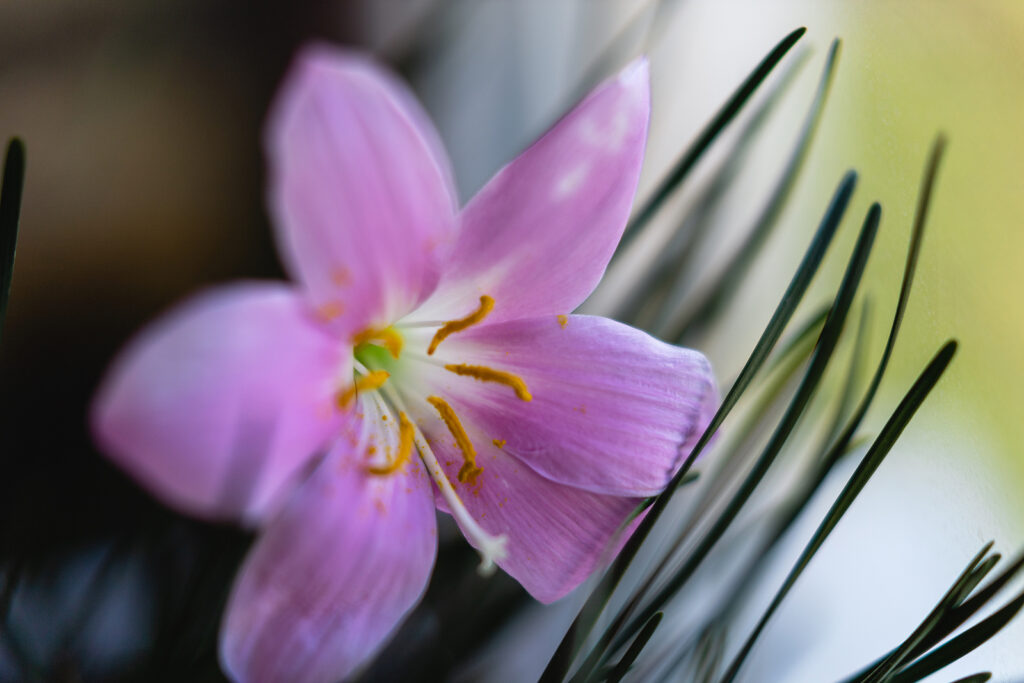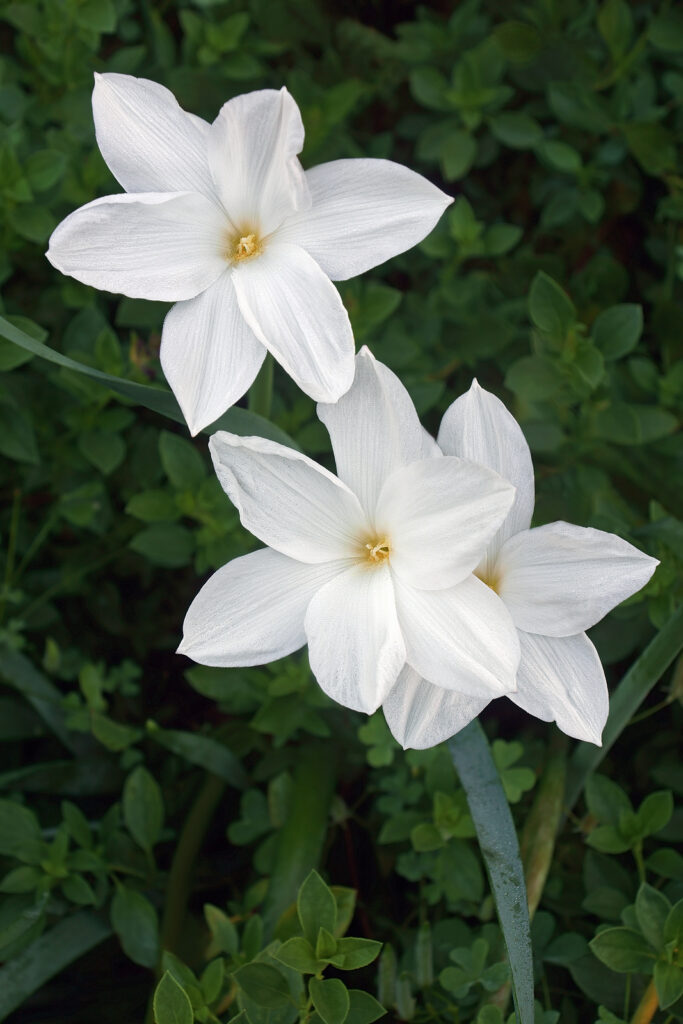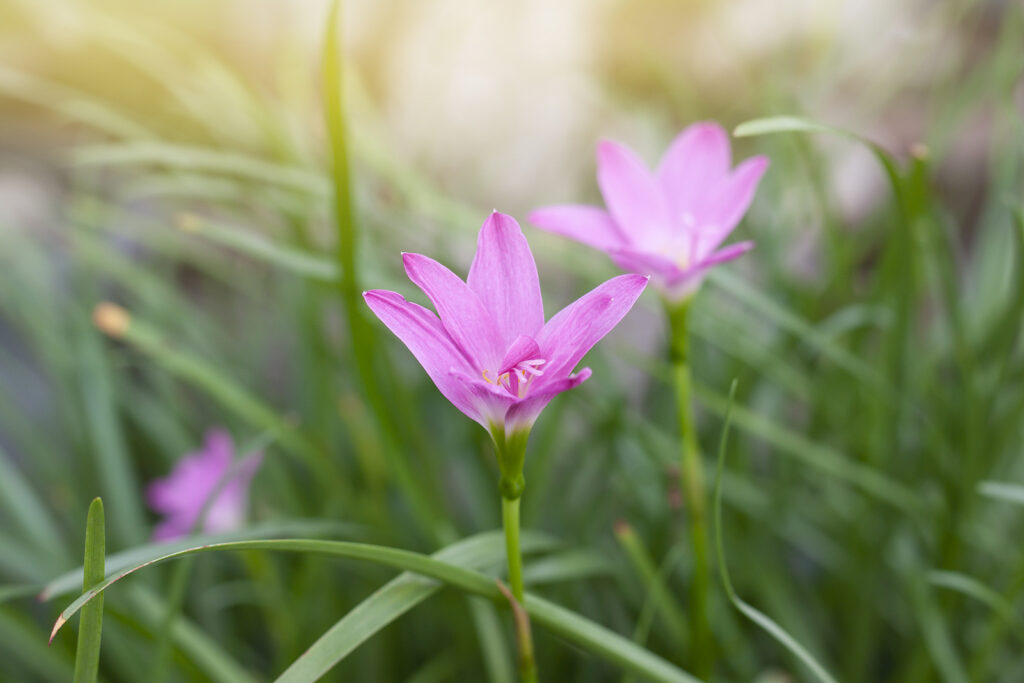Zephyrantes is grown for its upward-facing tubular flowers. Blossoms mostly resemble small lilies though some are rounded and resemble crocuses. Flowers appear in spring in shades of pink, red, yellow, or white. Some species bloom until fall.
Individual Zephyrantes flowers rise on slender, hollow stems, each bearing a single blossom. Flowers appear above clumps of foot-long, bright green, grassy leaves.
Zephyrantes often blooms following rain, thus it is commonly known as rain lily or rain flower. Other common names are zephyr lily and fairy lily.
Zephyrantes is a good choice for the front of borders, rock gardens, and containers. Zephyrantes can be grown indoors in cold-winter regions where they are not hardy.

Get to know Zephyranthes
- Plant type: Perennials from bulbs
- Growing zones and range: Zones 7-11
- Hardiness: Hardy in growing zones; needs protection in colder regions
- Height and width: 4 to 24 inches (10-61cm) tall and wide depending on species.
- Foliage: Leaves are grass-like and grow from the base of the plant in an arching habit
- Flowers: Funnel-shaped blossoms with six segments; flower colors include pink, rose-pink, and yellow
- Bloom time: Summer to fall; plants may bloom several times in a growing season.
- Uses: Plant in rock gardens or forefront of borders; good pot plant for patio or greenhouse
- Common name: Zephyr flower, rain lily, fairy lily
- Botanical name: Zephyranthes
- Family name: Amaryllidaeae
- Origin: Central and South America
Where to plant Zephyranthes
- Grow Zephyrantes in full sun, plant in partial shade in hot summer regions.
- Grow Zephyrantes in moist, humus-rich well-drained soil. Bulbs need dry soil in winter.
- In cold winter regions and where the soil stays wet in winter, grow Zephyrantes in containers.
- Zephyrantes prefers a soil pH of 6 to 7.

When to plant Zephyranthes
- Set bulbs in the garden spring through fall, but fall planting is ideal.
Planting and spacing Zephyranthes
- Plant bulbs 1 to 2 inches (2.5-5cm) deep and 3 inches (7.6cm) apart.
- Plants can remain undisturbed for many years.
How to water and feed Zephyranthes
- Give Zephyrantes regular water during growth and bloom periods.
- Fertilize Zephyrantes with a bulb-food or all-purpose fertilizer at planting time; feed established plants at the beginning of each growing season.
Zephyranthes care
- Provide a short dry period after the first bloom period and plants are likely to repeat bloom.
- Give plants little or no water after the foliage dies back in autumn.
- Gradually withhold water as the leaves die back.
- Bulbs can be lifted and stored in a dry, airy place in cold-winter regions; keep bulbs cool in winter at about 50°F (10°C).
- Container-grown plants bloom slightly better when pot-bound; re-pot Zehpyrantes every four years or so.
Growing Zephyrantes as a houseplant
- Give Zephyranthes a spot where the temperature is cool, light is direct, and humidity is medium to high.
- Grow in a soilless medium and keep it evenly moist while the plant is growing and flowering.
- Fertilize monthly.
- After the flowers have faced and foliage has started to turn brown, withhold water for two or three months to let the plant rest, then resume watering and fertilizing.
- Plants will bloom again in about 10 weeks.

Zephyranthes propagation
- Propagate Zephyrantes by offsets in spring or by seeds.
Zephyranthes varieties to grow
- Zephyrantes atamasco, atamasco lily: grows 8 to 12inches (20-30cm); bears white 3-inch-long funnel-shaped flowers in spring or summer.
- Z. candida: grows 4 to 8 inches (10-20cm) tall; bears creamy-white, crocus-like flowers from summer to fall.
- Z. citrina: grows 4 to 6 inches (10-15cm) tall with bright yellow crocus-like flowers from late summer to fall.
- Z. grandiflora, rain lily, rain flower, zephyr lily: grows 8 to 10 inches (20-25cm) tall; bars pink funnel-shaped flowers from late summer to fall.
- Z. rosea, rain lily, rain flower, zephyr lily: grows 6 to 8 inches (15-20cm) tall; bears pink, funnel-shaped flowers with white throats in fall.















